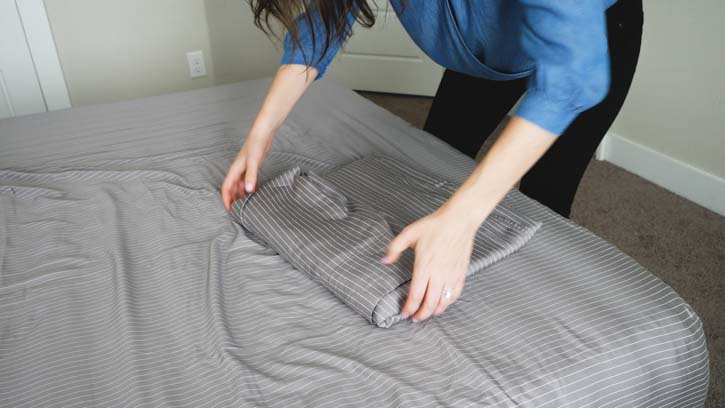Washing bed sheets regularly is really important! Body oils, dust mites, dead skin cells, and allergens all build up on your sheets over time and it’s important to remove them. If you’ve ever wondered about the right water temperature, rinse cycle, and dryer temperature to use when washing sheets, you’re in the right place. Take a look at the guide below to learn all that and more.
5 Steps to Wash Bed Sheets
Read on below for five simple steps for laundering sheets. If your sheets are made of fabric that requires special care, check out the guide below.
Step 1: Take Sheets Off Bed and Check Tags
After a week of use, strip your sheets off your bed and check the care label for any special washing instructions. If there are any special instructions on the tags be sure to follow them. If not, follow the steps below. If you’re washing several different sets of sheets, sort them into light and dark colors. We also recommend washing large items like comforters separately from sheets. If you do want to wash additional items with your sheets, items like cotton duvets and cotton t-shirts are good additions. Things like towels or jeans are too rough to wash with sheets, and can reduce the lifespan of your bedding.
Step 2: Pre-Treat Any Stains
Pre-treat any visible stains before putting your sheets in the washing machine. You can use a store-bought stain remover or a paste of baking soda and water. White vinegar is also a great stain remover! If you’re dealing with a difficult stain, like blood, check out our How to Get Blood Out of Sheets guide. If any liquids have soaked through onto your mattress, check out our How to Clean Your Mattress article to learn how to remove stains.

Step 3: Wash
Next, it’s time to put your sheets in the washer! Be sure not to overstuff your machine, sheets need room for the agitator to move them around during the wash cycle to really get clean. You should wash sheets in cold water (especially if they’re made of a delicate fabric like silk). This helps preserve the color on your sheets. But, if your sheets are heavily soiled you should wash your bedding in warm water. As a rule of thumb, avoid washing your sheets in hot water. This can wear sheets out faster and set in certain stains.
Use your machine’s regular, linen, or gentle cycle when washing. You should also use a gentle laundry detergent. If you’re washing white cotton sheets, add bleach (or use lemon juice as a natural alternative). If you’re washing white sheets made of a different fabric, check the tags before adding bleach. Do not use bleach on colored sheets. You can also use fabric softener at this time. But keep in mind fabric softener can lead to build up that actually makes your bed linens feel less soft over time. We recommend only using it every other wash.
Pro tip: If your sheets have been feeling stiff or dull, check out our How to Soften Bed Sheets guide for some tips.
Step 4: Dry
When it’s time to dry your sheets, you can air dry them on a clothesline or use a dryer. If you’re line drying, keep colored fabrics out of direct sunlight to prevent fading. White sheets can be dried in direct sun.
If you’re machine drying, shake your sheets out before putting them in the dryer. Throwing bundled up sheets from the washer right into the dryer can increase the drying time needed. Use a low heat setting when drying your sheets. This can prevent shrinkage and roughness, which can both result from over-drying. Use a tumble dry setting and either dryer balls or dryer sheets to prevent wrinkling and remove lint.
Step 5: Store
Now it’s time to store your clean sheets. Our favorite method is storing your folded fitted and flat sheets inside a pillowcase that matches the set. This keeps all your bedding together and makes it easy to make up your bed. Be sure to fold your dry sheets quickly to avoid wrinkling (ironing sheets is a real chore). Check out our How to Fold a Fitted Sheet article to learn the fastest way to fold your sheets!

Should You Wash New Sheets?
You should always wash new sheets before sleeping on them for the first time. New sheets can feel scratchy and uncomfortable because of heavy-duty starch used to keep them crisp-looking in their packaging. It’s a good idea to wash new sheets in cool water to ensure they feel soft and don’t irritate your skin. Washing new sheets can also make it easier to spot any small holes or loose threads. Finding defects quickly will allow you to take advantage of a return window if one is offered.
How to Wash Special Fabrics
Cotton and polyester blends are easy to care for, so you can use the steps above. But certain fabrics require special care. Take a look below to learn how to wash silk, satin, bamboo, and percale sheets.
Silk
Silk sheets and pillowcases should only be washed in cold water. Use a gentle detergent specifically formulated for silk. You can wash silk on the delicate setting in your washing machine and air dry it. You can also hand wash your sheets in the tub. If you hand wash your sheets, submerge them and gently agitate them, but don’t rub or scrub hard. Do not wring out your silk sheets before drying them. You can gently blot them with a white towel if they’re too wet to hang up right away.
Satin
Satin sheets can be washed exactly the same way as silk sheets. Remember to air dry and use a detergent specifically formulated for silk or satin fabrics.
Bamboo
Bamboo sheets should be washed in cold water and on the gentle setting. You can tumble dry bamboo sheets on low, but line drying is best for this fabric (especially if you want to preserve its ultra-soft feel). Make sure you do not use bleach on bamboo sheets, even if your sheets are white.
Percale
Percale can be washed just like any other cotton. That said, if you want to preserve the lifespan of your luxury sheets, we recommend avoiding fabric softener and bleach. It is also best to wash cotton percale in cool water and dry it on a low heat setting. Percale can shrink in the dryer, so we recommend removing it from the dryer while it’s still slightly damp. This will prevent over-drying and shrinkage. You can finish drying it on the line, or even put it right onto your bed! Percale wrinkles easily, so making your bed immediately is a great way to keep it looking smooth and crisp. Just avoid adding your comforter until your top sheet has dried.
FAQs
How often should you wash your bed sheets?
You should wash your bed sheets at least once per week. Check out our How Often Should You Wash Your Bed Sheets article to learn why.
What setting should you wash your sheets on?
You should use your washer’s regular setting to wash most sheets. It may also be labeled “permanent press.”
Can you put bed sheets in the dryer?
Yes, you can put most bedsheets in the dryer as long as you use a low heat setting. Make sure you check your sheets’ care label before machine drying them.

